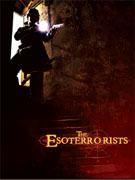 For the GUMSHOE system (used in The Esoterrorists and The Trail of Cthulhu), Robin D. Laws decided to get rid of the concept of needing to find clues. In each “scene” of an investigation scenario, there is a “clue”. It’s automatically assumed that the investigators will find this clue.
For the GUMSHOE system (used in The Esoterrorists and The Trail of Cthulhu), Robin D. Laws decided to get rid of the concept of needing to find clues. In each “scene” of an investigation scenario, there is a “clue”. It’s automatically assumed that the investigators will find this clue.
This removes three of our four chokepoints, leaving only the necessity of using the clue to make the correct deduction (i.e., the deduction which moves you onto the next “scene” where the next clue can be imparted). And, in the case of the GUMSHOE system, even this step can be tackled mechanically (with the players committing points from their character’s skills to receive increasingly accurate “deductions” from the GM).
This is a mechanical solution to the problem. But while it may result in a game session which superficially follows the structure of a mystery story, I think it fails because it doesn’t particularly feel as if you’re playing a mystery.
Laws’ fundamental mistake, I think, is in assuming that a mystery story is fundamentally about following a “bread crumb trail” of clues. Here’s a quote from a design essay on the subject:
I’d argue, first of all, that these fears are misplaced, and arise from a fundamental misperception. The trail of clues, or bread crumb plot, is not the story, and does not constitute a pre-scripted experience. What the PCs choose to do, and how they interact with each other as they solve the mystery, is the story. As mentioned in The Esoterrorist rules, we saw this at work during playtest, as all of the groups had very different experiences of the sample scenario, as each GM and player combo riffed in their own unique ways off the situations it suggested.
But, in point of fact, this type of simplistic “A leads to B leads to C leads to D” plotting is not typical of the mystery genre. For a relatively simplistic counter-example, let’s return to Sherlock Holmes in A Study in Scarlet:
WATSON: “That seems simple enough,” said I; but how about the other man’s height?”
HOLMES: “Why, the height of a man, in nine cases out of ten, can be told from the length of his stride. It is a simple calculation enough, though there is no use my boring you with figures. I had this fellow’s stride both on the clay outside and on the dust within. Then I had a way of checking my calculation. When a man writes on a wall, his instinct leads him to write above the level of his own eyes. Now that writing was just over six feet from the ground. It was child’s play.”
This is just one small deduction in a much larger mystery, but you’ll note that Holmes has in fact gathered several clues, studied them, and then distilled a conclusion out of them. And this is, in fact, the typical structure of the mystery genre: The detective slowly gathers a body of evidence until, finally, a conclusion emerges. In the words of Holmes himself, “When you have eliminated the impossible, whatever remains, however improbable, must be the truth.”
What is true, however, is that in many cases it is necessary for many smaller deductions to be made in order for all of the evidence required to solve the mystery to be gathered. However, as the example from A Study in Scarlet demonstrates, even these smaller deductions can be based on a body of evidence and not just one clue in isolation.
This observation leads us, inexorably, to the solution we’ve been looking for.
Continued tomorrow…











